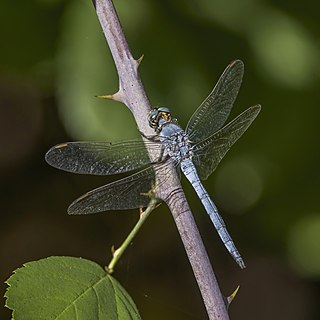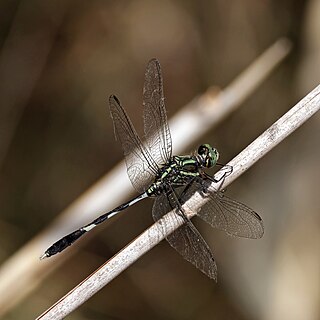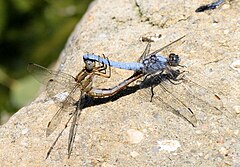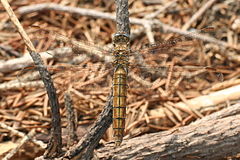
The black-tailed skimmer is a dragonfly belonging to the family Libellulidae.

The red-veined darter or nomad is a dragonfly of the genus Sympetrum.

The keeled skimmer is a species of dragonfly belonging to the family Libellulidae.

The blue-tailed damselfly or common bluetail is a damselfly, belonging to the family Coenagrionidae.

Orthetrum villosovittatum, known as the fiery skimmer, is a species of dragonfly in the family Libellulidae. Its range is from the Moluccas, New Guinea and neighbouring islands as well as Australia. In Australia it is found in Victoria through eastern New South Wales and Queensland, north inland Queensland, Cape York Peninsula and north Northern Territory. It is a common species through most of its range.

Orthetrum caledonicum, the blue skimmer, is a common Australian dragonfly in the family Libellulidae.

Orthetrum sabina, the slender skimmer or green marsh hawk, is a species of dragonfly in the family Libellulidae. It is widespread, being found from south-eastern Europe and North Africa to Japan and south to Australia and Micronesia.

Eastern forktail is a member of the damselfly family Coenagrionidae.

Sympetrum meridionale, the southern darter, is a species of dragonfly belonging to the Skimmer family Libellulidae.

Orthetrum migratum is an Australian freshwater dragonfly species in the family Libellulidae. The common name for this species is rosy skimmer. It inhabits streams, boggy seepages, riverine pools and swamps across northern Australia.

Orthetrum taeniolatum is an Asian freshwater dragonfly species. The common name for this species is small skimmer. Its range of distribution spreads from eastern Europe to China, and the species itself is locally common throughout the range.

Orthetrum serapia, the green skimmer, is a freshwater dragonfly in the family Libellulidae. The serapia species is present in Australia, the Philippines, Fiji, Papua New Guinea and Solomon Islands. It inhabits a wide range of still and sluggish waters, often shallow. In Australia it ranges from the top end of the Northern Territory to about Mackay in central Queensland.

Orthetrum boumiera is a freshwater dragonfly species in the family Libellulidae, endemic to eastern Australia, where it inhabits dune lakes. The common name for this species is brownwater skimmer.

Cratilla lineata, the line forest-skimmer, emerald-banded skimmer or pale-faced forest-skimmer, is a species of dragonfly in the family Libellulidae. It is found in many Asian countries.

Indothemis carnatica, the black marsh skimmer, or light-tipped demon, is a species of dragonfly in the family Libellulidae. It is found in India, Sri Lanka and Thailand.

The Spine-tufted skimmer, or brown-backed red marsh hawk, is a species of dragonfly in the family Libellulidae. It is widespread in many Asian countries.

The marsh skimmer, also known as tricolored marsh hawk, and slender blue skimmer, is a species of dragonfly in the family Libellulidae. It is widespread in many Asian countries.

Orthetrum testaceum, common names Crimson Dropwing or Orange Skimmer. is an Asian freshwater dragonfly species belonging to the family Libellulidae.

The blue corporal, also known as little corporal, is a dragonfly in the Libellulidae, or skimmer family. First described as Libellula deplanata by Jules Pierre Rambur in 1842, it is common across much of the eastern United States.























